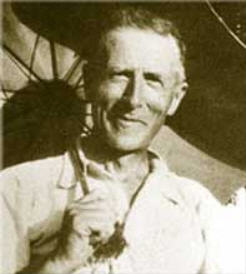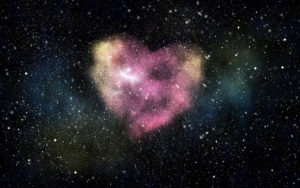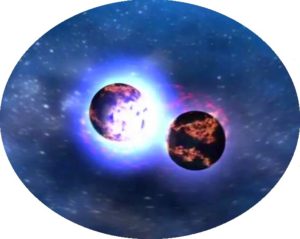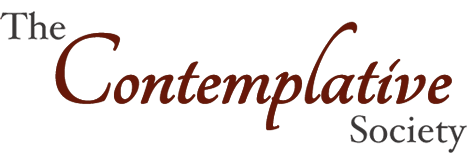Love is the Answer – What is the Question?
This blog post first by Cynthia Bourgeault appeared on Ilia Delio’s new website, The Omega Center on September 12, 2016.
I was a hidden treasure and I longed to be known. And so I created the world, both visible and invisible.
This famous saying from the Hadith Qudsi, the extra-koranic sayings of Islam, speaks to the question of why God would want to bring creation into existence in the first place. Astonishingly, the reason given is not for majesty or dominion, but for intimacy, the yearning for self-disclosure, to know and be known. Seeded into the cosmos is that same primordial yearning, reverberating as a psychic harmonic of the big bang.
 Teilhard de Chardin probably never encountered this quote. His familiarity with Islam was painfully limited, particularly in its mystical and Sufi branches with which he was ironically so deeply in tune. But in a real sense, this little gem of Islamic wisdom almost perfectly encapsulates Teilhard’s own magisterial understanding of cosmic love, transparency, and the personal.
Teilhard de Chardin probably never encountered this quote. His familiarity with Islam was painfully limited, particularly in its mystical and Sufi branches with which he was ironically so deeply in tune. But in a real sense, this little gem of Islamic wisdom almost perfectly encapsulates Teilhard’s own magisterial understanding of cosmic love, transparency, and the personal.
How did we get to be here? How did anything get to be here? Teilhard judiciously sidesteps the classic metaphysical stipulation of a fall, an “involution” into matter. As a scientist rather than a metaphysician, he does not have to begin with the grand “why” of things; the “what” of them will suffice. And what he actually observes seeded into the stuff of the universe is a paradoxical dialectic: intense atomicity, granulation, the myriad bits and pieces of our materiality—and yet, at the same time, an underlying unity, and a force calling the “unorganized multitude” to move in the direction of “the unified multiple”.¹ However the pieces may have gotten broken in the first place, what he observes everywhere in the universe is a countering force—he names it love—moving beneath the pixilated surface drawing all things together. “Driven by the force of love,” he writes, “the fragments of the universe [continuously] seek each other so that the world may come into being.”
For Teilhard, love is not first and foremost a sentiment, let alone a sentimentality. It is first and foremost a geophysical force, built into the very structure of the cosmos. In an astonishing one-liner toward the end of The Human Phenomenon he writes:
In all its nuances, love is nothing more or less than the direct or indirect trace marked in the heart of the element by the psychic convergence of the universe upon itself.²

In other words, if you’re familiar with his theories of complexification and convergence, he’s saying that this primordial impulse toward unification (experienced at the biophysical level as attraction and at the psychic as eros) actually has its antecedent in the physical shape of our planet itself, its perfect sphericity inherently designed to shove things closer and closer together so that they converge, complexify, and grow more conscious. Whether by chance, “intelligent design,” or its own innate teleology, the whole thing seems to be set up like a cosmic gristmill for the extraction of consciousness.
When we love, then—when our own hearts reach out in tenderness, desire, or plain old physical attraction—Teilhard asks us to remember that the cosmos, too, passed this way, seeking at the macro-level what we are now experiencing at the micro. We are in each another holographically, this world and us: the whole of the “universe story” carved in our own hearts, and the whole of our own story reverberating within the cosmic heart.
 Like that great other cosmological visionary Jacob Boehme (1585-1624), Teilhard has a penchant for moving back and forth very quickly between the physical and psychic realms. What for Boehme is friction at a physical level very quickly becomes anguish at an emotional level; hence, he can speak of the anguish of creation awakening to itself. In a similar way, Teilhard moves between the “outside” of things and their “inside.” From the outside perspective, love is a form of energy. It is an aspect—no doubt the primary aspect—of what he calls radial energy, the energy of evolution, the energy released in the process of complexification/consciousness. It is the force that runs through the cosmos as an energetic counter-current to the Second Law of Thermodynamics, drawing things to become more unified, vitalized, and whole. From the inside—the psychic perspective—love retains its traditional meanings of compassion, intimacy, and generativity, drawing things to become more deeply themselves—“I am, may you be also,” as Beatrice Bruteau concisely summarizes it. But it also conveys for Teilhard an additional connotation: spiritualization, which means the release of yet another quantum packet of that sum total of consciousness and conscience (and, in French, they are the same word!) seeded into the cosmos in that initial eclosion of divine yearning that launched the whole journey in the first place.
Like that great other cosmological visionary Jacob Boehme (1585-1624), Teilhard has a penchant for moving back and forth very quickly between the physical and psychic realms. What for Boehme is friction at a physical level very quickly becomes anguish at an emotional level; hence, he can speak of the anguish of creation awakening to itself. In a similar way, Teilhard moves between the “outside” of things and their “inside.” From the outside perspective, love is a form of energy. It is an aspect—no doubt the primary aspect—of what he calls radial energy, the energy of evolution, the energy released in the process of complexification/consciousness. It is the force that runs through the cosmos as an energetic counter-current to the Second Law of Thermodynamics, drawing things to become more unified, vitalized, and whole. From the inside—the psychic perspective—love retains its traditional meanings of compassion, intimacy, and generativity, drawing things to become more deeply themselves—“I am, may you be also,” as Beatrice Bruteau concisely summarizes it. But it also conveys for Teilhard an additional connotation: spiritualization, which means the release of yet another quantum packet of that sum total of consciousness and conscience (and, in French, they are the same word!) seeded into the cosmos in that initial eclosion of divine yearning that launched the whole journey in the first place.
When Teilhard speaks of “harnessing the energy of love,” he is speaking in both senses, both inside and outside. In the end, they are holographically embedded in one another, so the bridge between the cosmic processes and our own hearts is trustworthy.
Thus, we can look to our own hearts to tell us more about what Teilhard sees as the essence of the complexification/consciousness process—and hence, of evolution (and hence, of love): his insistence that “union differentiates.” We often think of love in terms of merging, uniting, becoming one, but Teilhard was wary of such definitions; his practiced eye as an evolutionist taught him something quite different. True union—the ultimate chef d’oeuvre of love—doesn’t turn its respective participants into a blob, a drop dissolving in the ocean. Rather, it presses them mightily to become more and more themselves: to discover, trust, and fully inhabit their own depths. As these depths open, so does their capacity to love, to give-and-receive of themselves over the entire range of their actualized personhood.
The term “codependency” was not yet current in Teilhard’s day, but he already had the gist of it intuitively. He knew that love is not well served by collapsing into one another. It is better served by standing one’s own ground within a flexible unity so that more, deeper, richer, facets of personhood can glow forth in “a paroxysm of harmonized complexity”.³
The poet Rilke, Teilhard’s contemporary and, in many respects, kindred spirit, is on exactly the same wavelength. “For what would be a union of two people who are unclarified, unfinished, and still incoherent?” he asks in his Letters to a Young Poet. “Love is a high inducement for the individual to ripen, to become something in himself, to become world, to become world in himself for the sake of another.”
“To become world in oneself for the sake of another…” Hmmmm. Does love really ask us to become world? Does love make worlds? Is that what love does?
True, Teilhard does not directly tackle the question of first causes. But a clue to the cosmological riddle is surely embedded in his understanding of love as the driveshaft of evolution. Suppose this love is not a pre-existent “property” attributable to God, as in the classic substance theology of the past. Suppose it is instead an alchemical process: a tender and vulnerable journey of self-disclosure, risk, intimacy, yearning, and generativity whose ley lines are carved into the planet itself. The whole universe story has come into being because God is a hidden treasure who longs to be known. And the way—the only way—this knowing can be released is in the dance of unity-in-differentiation which is the native language of love. If it takes a whole village to raise a child, it takes a whole cosmos to bear forth the depths of divine love.
Notes:
-
- Teilhard de Chardin, Pierre. The Human Phenomenon. ed. Sarah Appleton-Weber. Sussex Academic Press: 2003. Page 28.
- Ibid. Page 188.
- Ibid. Page 184.












I really love the question by Carey about distinguishing addictive love from deep spiritual love. For me it is a process. When love starts to agonize I get the opportunity to look at my reactivity and learn who I am more deeply, as opposed to what my beloved is doing to me. I don’t necessarily get to avoid the same reactivity over again but I do get a bit deeper each time. I am a slow learner. I don’t think, from this, that anyone should necessarily stay in a pain inducing love relationship for ever. But I do like looking for my contribution and avoiding the blame or any kind of resignation.
I wonder if you would be willing to read Facing Love Addiction by Pia Mellody and integrate the very painful misunderstandings human beings can get about love (by nature of being human perhaps, attachement styles and more) with the deep and profound ideas about love that permeate much of what you write. I am completely confused about how to integrate healthy, responsibility for my humanness, human psyche, human relationships with the deep profound spiritual concepts that seem to have the power to keep one trapped in plain old, extremely painful, unhealthy love addiction. Then I tell myself agony is just a part of it, etc instead of making some responsible choices for how I am using mystical ideas to perpetuate an addiction….I think there would be great value in a deep soul taking in this other perspective and reporting back how you see these things fitting together, Cynthia. Thank you for considering it. I think it would be a true gift to all of the souls engaged here.
Christ is love !! What a marvelous way to explain The Force of Love, after all everything belongs, this is music to the soul that makes me want to dance.
Thank You!!
Paloma
In my early Sufi training in the Chisti Order, I was taught that “love” is the force that holds everything together: ” ishk”. It is the force between molecules and atoms.
This fits with “God is Love, Lover and Beloved.”
Btw I am a Christian Sufi.